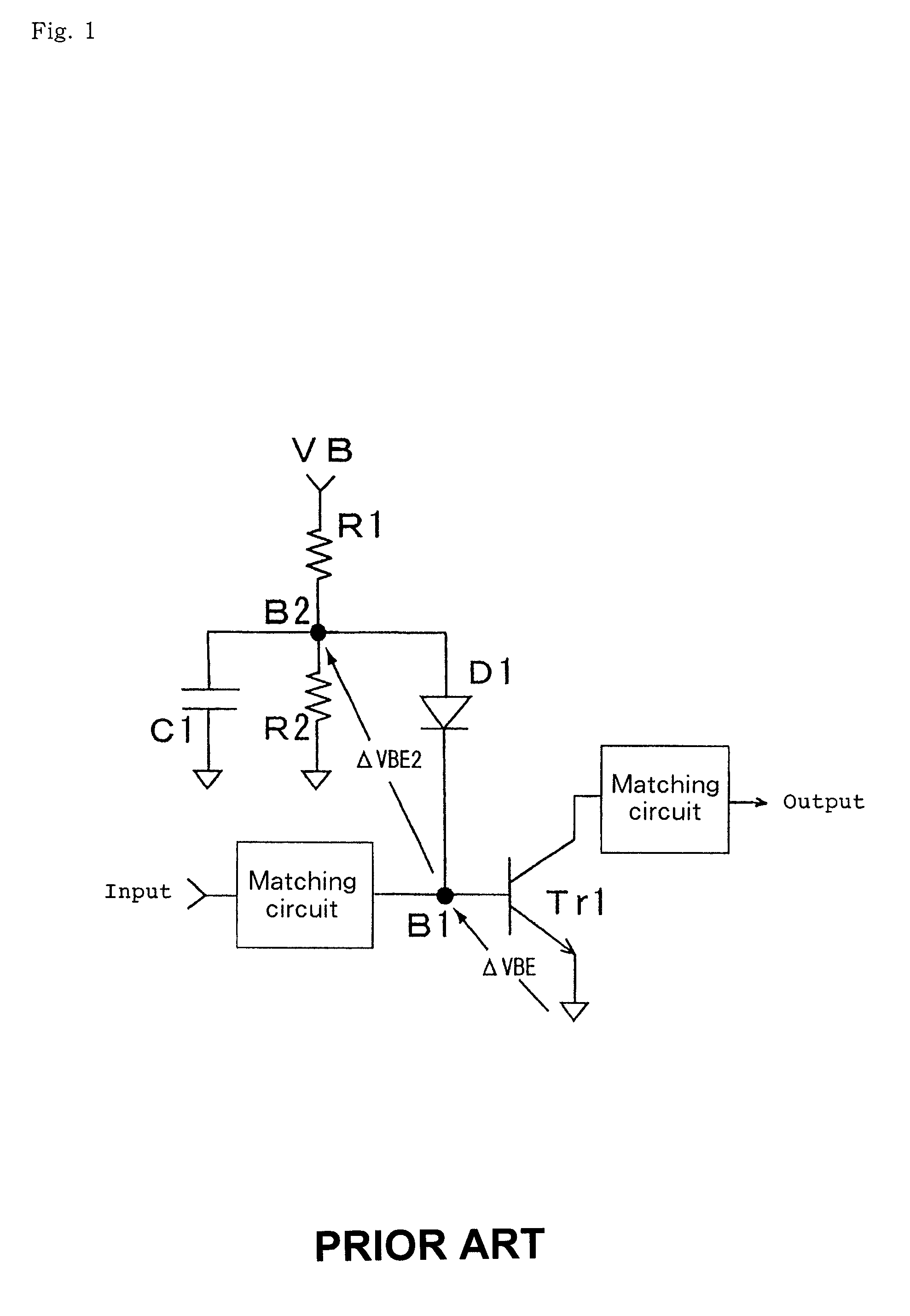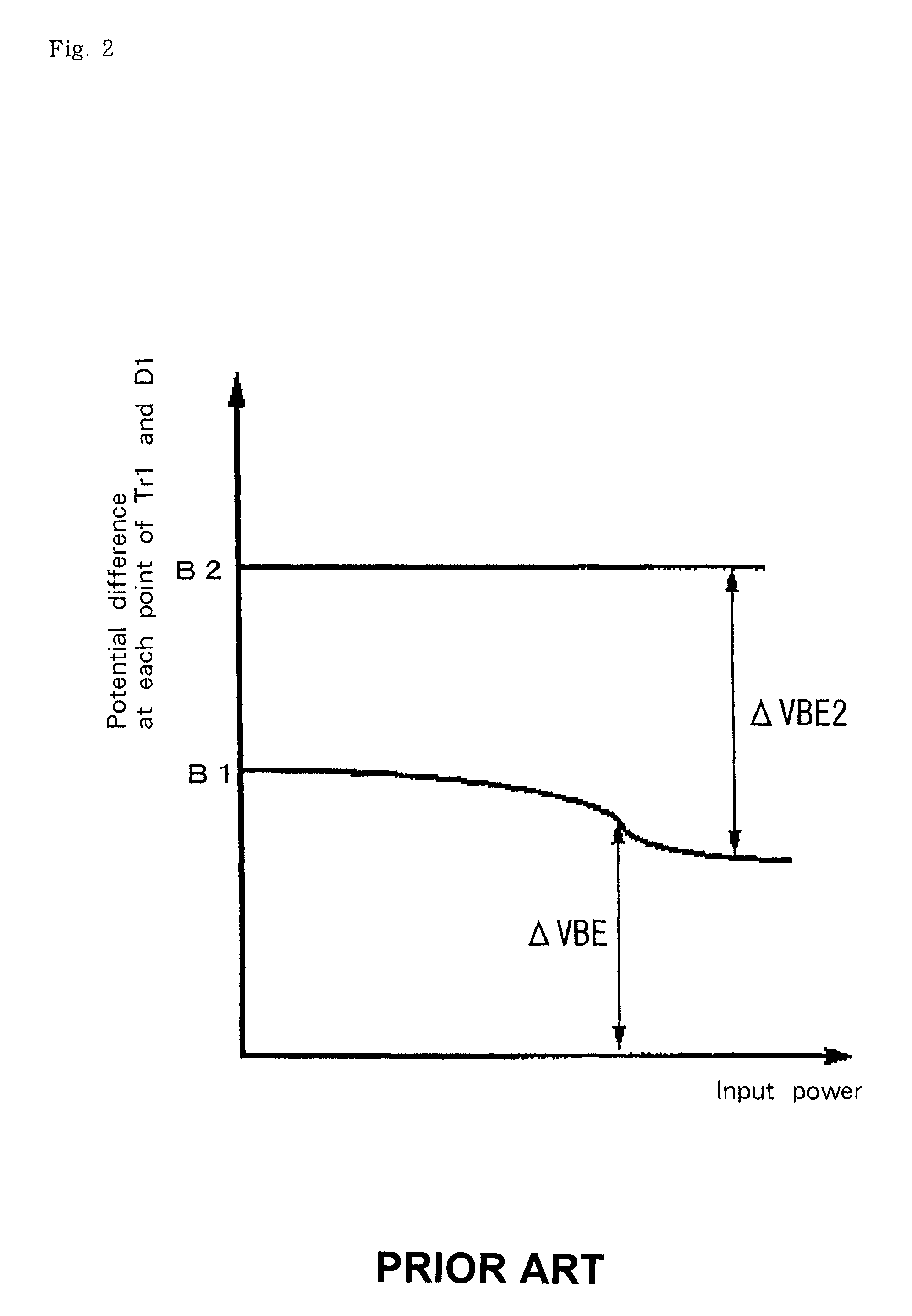Amplifier
a technology of amplifiers and amplifiers, applied in the field of amplifiers, can solve the problems of linearity degradation, increased power consumption, and reduced power added efficiency, and achieve the effect of high power added efficiency
- Summary
- Abstract
- Description
- Claims
- Application Information
AI Technical Summary
Benefits of technology
Problems solved by technology
Method used
Image
Examples
first embodiment
[0171]FIG. 24 is a diagram illustrating an amplifier which inverts the phase of IM3 with respect to a basic wave according to a first embodiment of the present invention. Amplifying transistor 1 forms an emitter grounded amplifier circuit, where transistor 1 has a base, through impedance element 2, which is connected to input matching circuit 3 and to a cathode of bias supply diode 4. Bias supply diode 4 has an anode connected to reference power supply 5 which presents a sufficiently low impedance at high frequencies. Transistor 1 has a collector connected to collector power supply 7 through load 6 and to output terminal 9 through output matching circuit 8.
[0172]FIG. 24, which illustrates this embodiment, corresponds to FIG. 1 which illustrates the first conventional example. In comparing the first embodiment illustrated in FIG. 24 with the first conventional example of FIG. 1, bias supply diode D1 has the cathode connected directly to the base terminal of amplifying transistor Tr1 ...
second embodiment
[0173]FIG. 27 is a diagram illustrating an amplifier which inverts the phase of IM3 with respect to the basic wave according to a second embodiment of the present invention, and corresponds to FIG. 4 of the second conventional example. This embodiment uses the base-emitter of bias supply transistor 11 instead of diode 4 in the first embodiment. Therefore, the effect and operation are the same as those of the first embodiment. This embodiment alleviates the aforementioned second problem in which, when reference power supply 5 is implemented by a resistor, the resistor causes a voltage drop. In this embodiment, since the bias is also supplied to amplifying transistor 1 through impedance element 21, this impedance element 21 does not block any DC current. Since this embodiment is substantially identical to the aforementioned first embodiment in effect and operation, they will be jointly described below in this embodiment.
[0174]FIG. 25 is a diagram for describing the second embodiment o...
third embodiment
[0181]FIG. 30 is a diagram illustrating an amplifier which inverts the phase of IM3 with respect to the basic wave according to a third embodiment of the present invention. Amplifying transistor 1 forms an emitter grounded amplifier circuit, where the base of transistor 1 is biased by bias supply diode 23. Also, the same transistor 1 has a base connected to input matching circuit 3 and bias supply diode 24 through impedance element 25. Anodes of Bias supply diodes 23 and 24 have their anodes connected to reference power supply 5. Transistor 1 has a collector which is connected to collector power supply 7 through load 6 and which is also connected to output terminal 9 through output matching circuit 8.
[0182]Since this embodiment is identical in effect and operation to a fourth to a sixth embodiment, later described, they will be jointly described in the sixth embodiment.
PUM
 Login to View More
Login to View More Abstract
Description
Claims
Application Information
 Login to View More
Login to View More - R&D
- Intellectual Property
- Life Sciences
- Materials
- Tech Scout
- Unparalleled Data Quality
- Higher Quality Content
- 60% Fewer Hallucinations
Browse by: Latest US Patents, China's latest patents, Technical Efficacy Thesaurus, Application Domain, Technology Topic, Popular Technical Reports.
© 2025 PatSnap. All rights reserved.Legal|Privacy policy|Modern Slavery Act Transparency Statement|Sitemap|About US| Contact US: help@patsnap.com



